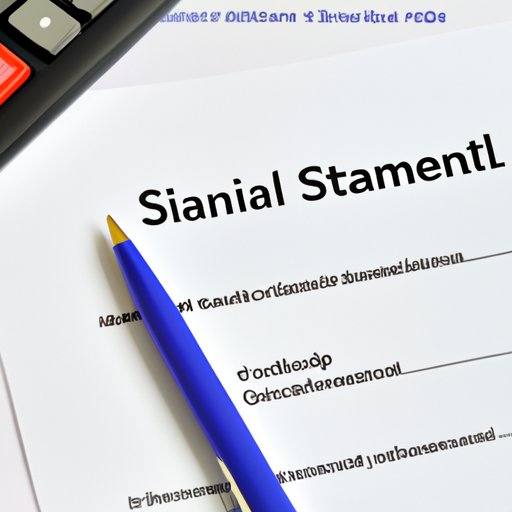Introduction
Financial statements are vital tools for businesses and individuals seeking to understand their financial health. However, understanding the order in which financial statements are prepared can be a challenge. In this article, we’ll guide you through the step-by-step process of financial statement preparation, helping you understand each statement’s purpose and how they fit together.
Mastering Finance: Understanding the Order of Financial Statement Preparation
Understanding the order in which financial statements are prepared is essential. Financial statements provide information about a company’s financial position, performance, and cash flow over a specific period. The reports are usually generated quarterly or annually. The order of preparation comprises the following:
– Trial Balance
– Income Statement
– Balance Sheet
– Cash Flow Statement
From Trial Balance to Cash Flow: The Step-by-Step Guide to Preparing Financial Statements
Now let’s take a closer look at each statement’s role and purpose in the financial statement preparation process.
Trial Balance
The trial balance is an internal report that lists all of a company’s account balances. It is the foundation for the remaining financial statements. The purpose of the trial balance is to ensure that the total debits equal the total credits.
Income Statement
The income statement reports a company’s revenues, expenses, and net income over a specific period. It shows whether a company is profitable or not by comparing revenues with expenses. The purpose of the income statement is to provide insight into how much money a company makes or losses.
Balance Sheet
The balance sheet reports a company’s assets, liabilities, and equity at a specific time. Assets are anything a company owns that can be converted into cash, such as property, inventory, or investments. Liabilities are obligations, such as loans or debts, and equity is the residual interest in the assets of the company after deducting liabilities. The purpose of the balance sheet is to help investors understand the value of the business.
Cash Flow Statement
The cash flow statement reports the inflow and outflow of cash within a company over a specific period. It shows how much cash a company generates from its operations and how much it invests in capital expenditures. The purpose of the cash flow statement is to give investors insight into the company’s liquidity.
The Financial Statement Prep Process: A Beginner’s Guide
Financial statement preparation can seem daunting. Still, it’s a critical part of running a business or managing your finances. Let’s break down the process into manageable steps.
Step 1: Get Your Trial Balance in Order
The trial balance is the first step in the financial statement preparation process. The trial balance lists all of a company’s accounts and their balances. The trial balance should balance, which means that total debits equal total credits.
Step 2: Prepare the Income Statement
Once the trial balance is in order, prepare the income statement. The income statement reports all of a company’s revenues, expenses, and net income for a specific period. To prepare the income statement, start with revenues, deducting expenses from revenues to determine net income.
Step 3: Prepare the Balance Sheet
After preparing the income statement, the balance sheet should be prepared. The balance sheet reports all of a company’s assets, liabilities, and equity at a specific time. To prepare the balance sheet, list all of the company’s assets, then list all of its liabilities. The difference between assets and liabilities is equity.
Step 4: Prepare the Cash Flow Statement
Finally, prepare the cash flow statement. The cash flow statement reports all the inflows and outflows of cash within a company. Like the other statements, the cash flow statement should be prepared for a specific period.
Step 5: Make Adjustments and Classifications
Once you’ve prepared all four statements, review them for accuracy. Sometimes adjustments may be needed to align the statements’ figures. In addition, the classification of accounts may be reviewed for accuracy as accounts may be reclassified to fit more accurately in a specific statement.
Navigating the Maze of Financial Statements: How to Get Them in Order
Although the financial statement preparation process may seem straightforward, issues may arise when preparing them. Here are a few tips to help you stay organized and avoid potential mistakes:
– Keep Complete Records: Maintaining complete and accurate records can save you time and errors down the line.
– Use Accounting Software: Accounting software can help automate the financial statement preparation process, saving you time and ensuring accuracy.
– Reconcile Accounts Regularly: Reconciling accounts frequently can catch errors and discrepancies quickly.
– Hire a Professional Accountant: If you’re not comfortable with financial statement preparation, hire a professional accountant to help you navigate the process.
A Comprehensive Look at Financial Statement Preparation: Steps, Timing, and Importance
Financial statement preparation is a vital part of running a business or managing your finances. The timing of each statement’s preparation is essential since each statement provides a different snapshot of a company or individual’s financial health.
– Quarterly Statements: Some companies opt for quarterly financial statements to track their progress.
– Annual Statements: Annual financial statements are mandatory for the majority of businesses and individuals.
– Ad Hoc Reports: Ad hoc financial statements are useful for ad hoc reporting purposes.
Best practices in financial statement preparation include:
– Maintaining Accurate Records
– Using Accounting Software to Automate Preparation
– Hiring a Professional Accountant to Assist You
– Maintaining Compliance with Relevant Accounting Standards
Conclusion
Understanding the order of financial statement preparation is essential in managing a business or personal finance. The trial balance, income statement, balance sheet, and cash flow statement all play an integral role in the financial statement preparation process. By following our step-by-step guide, you’ll be able to prepare financial statements with confidence and avoid common pitfalls. Don’t forget to keep accurate and complete records, reconcile accounts frequently, and consider hiring a professional accountant to help you navigate the process.
